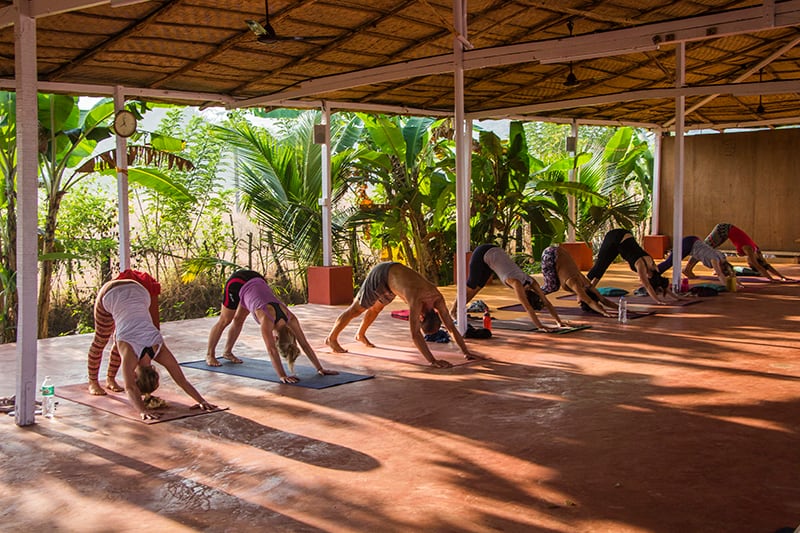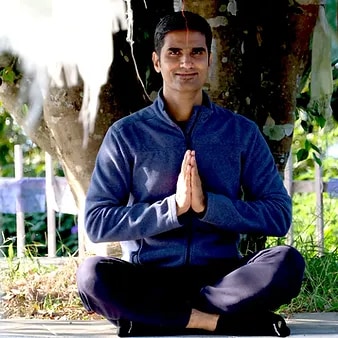An Overview of Ashtanga Vinyasa Yoga - Origin, Practices and Benefits
by Hardik Mehta
Many a times students get confused between Ashtanga Yoga and Ashtanga Vinyasa Yoga. They both are completely different. Sage Patanjali in his Yoga Sutras has mentioned “Ashtanga Yoga” which is the yoga of Eight Limbs that aims to reach the state of Chitta Vritti Nirodha which can be translated as attenuation of modifications of the mind. The Yoga sutras of Sage Patanjali is an ancient text that contains 195 sutras (aphorisms).

The word “Ashtanga” comes from two Sanskrit words: “Ashta” and “Anga.” “Ashta” means “eight,” and “Anga” means “limb” or “part of the body.” The Eight Limbs of Ashtanga Yoga are mentioned below:
Yama (moral codes), Niyama (self-discipline), Asana (posture), Pranayama (breath control), Pratyahara (sense withdrawal), Dharana (concentration), Dhyana (meditation), and Samadhi (spiritual absorption).
Ashtanga Vinyasa Yoga is considered as a subdivision of Hatha Yoga originated by the teachings of Sage Vamana explained in his text “Yoga Korunta”.
Ashtanga Vinyasa Yoga is based on a vigorous physical practise that involves a series of poses linked together with breath to make a continuous routine. The practise requires a lot of physical strength, flexibility, and stamina, which is why many people think of it as a tough practice. Adding an Ashtanga Vinyasa practice to your daily routine is a good way to keep your mind and body healthy and strong, whether you’re just starting out with yoga or looking for something new as your goals change.
Ashtanga Vinyasa style of practicing Asanas is very active and athletic. It is made up of six series or levels, and the poses are always done in the same sequence. It is based on vinyasa, which is a way of moving smoothly from one pose to the next while focusing on energy and breath. Even though it is a very physical practise, it also helps clear the mind and find peace within.
The six series are
- The Primary series: Yoga Chikitsa, Yoga for Health or Yoga Therapy
- The Intermediate series: Nadi Shodhana, The Nerve Purifier (also called the Second series)
- The Advanced series: Sthira Bhaga, Centering of Strength
- Advanced A or Third series
- Advanced B, or Fourth series
- Advanced C, or Fifth series
- Advanced D, or Sixth series
Origins of Ashtanga Vinyasa Yoga
As the story goes, the Ashtanga yoga system was reconstructed from a mysterious manuscript written on a bundle of palm leaves, the Yoga Korunta. This collection of verses on hatha yoga was discovered in the 1930’s by yoga master and Sanskrit scholar Sri Tirumalai Krishnamacharya and his disciple K. Pattabhi Jois while researching Sanskrit texts at a Calcutta university library. The manuscript is dated to be between 500 and 1,500 year old.
Krishnamacharya and Jois translated and reconstructed the Ashtanga yoga series (originally there were six sequences of postures) and Pattabhi Jois, with the encouragement of Krishnamacharya, took the instructions as the basis of his practice and teaching. Ashtanga taught by Pattabhi Jois is a form of hatha yoga which focuses on asana (posture) and pranayama (breath control). Eventually, it led to many different styles of yoga like hot yoga, Flow or Vinyasa yoga, and Power yoga.
The Ashtanga Yoga Research Institute is in Mysore, India. It helps spread the lessons and trainings of Ashtanga. R. Sharath Jois, who is Pattabhi Jois’s grandson, runs the school and is the most knowledgeable person on the subject. David Swenson, Kino MacGregor, Richard Freeman, Maty Ezraty, Tim Miller, David Williams, Chuck Miller, and Tim Feldmann are some of the other well-known Ashtanga yoga teachers who teach all over the world.
Key principles and techniques
It is based on a few key ideas. This multifaceted method helps improve both physical and mental health. For an ashtanga practise to work, you need to follow these five rules.
Ashtanga is a type of yoga. Vinyasa means “flow.”
Ujjayi pranayama: This particular way of breathing is used all through the practise. The “Victorious Breath” is a slow, audible way to breathe that is used to warm up, get more energy, and improve attention and focus. Advanced students are the only ones who learn more pranayama methods.
Drishti: Each asana has a different drishti, or point of focus. This helps to make the practise more focused and peaceful.
Vinyasa: It is a style of yoga in which the most important part of the practise is coordinating the breath with the pattern of poses and changes between them.
Bandha: Throughout the class, you are encouraged to use your body locks, or bandhas, to hold in the prana energy and make your core more stable.
Daily Practice: People are told to stick to a schedule six days a week, with Saturday as a day off. “Moon days,” or days when the moon is full or new, are also rest days, and women usually don’t practise when they are having their periods.
Asanas in this style are done in a set order, while vinyasa is more free-form and unstructured. At the beginning and end of an Ashtanga Vinyasa class, the students chant Opening & Closing prayer to bow down to Guru and Sage Patanjali.
What does Ashtanga Vinyasa Yoga try to do?
It’s intense physical practises are all about pushing through mental blocks and emotional baggage to develop mental clarity, mindful breathing, physical strength, flexibility, and stamina. The way the practise is set up and how often you do it are meant to help you quickly improve your body and general health. The set order of poses makes a strong framework that lets you focus on the inner parts of the yoga sutras.
Benefits of practicing Ashtanga Vinyasa Yoga
It focuses on the breath, movements, and meditation, just like most other types of hatha yoga. When you do yoga regularly, you can improve your balance, breathing, and flexibility. It can give you more energy, make your bones and muscles stronger, keep your weight in check, lower your blood pressure, and help you feel less stressed. Ashtanga Vinyasa Yoga has more benefits than just those that are physical. It also helps your mind and spirit by making you more clear-headed, calming your mind, and helping you focus better in everyday life.
Join our 200 Hours TTC in Goa to study Ashtanga Yoga of Sage Patanjali and practice Ashtanga Vinyasa Primary Series.
About the Author

Hardik Mehta
Hardik is an E-RYT 500 & YACEP (Yoga Alliance Continuing Education Provider), Yoga Alliance, USA. He has been practicing yoga for the last 9 years. Prior to finding his true calling in Yoga, he was working with various corporates for 12 years in the Retail and eCommerce sector.
